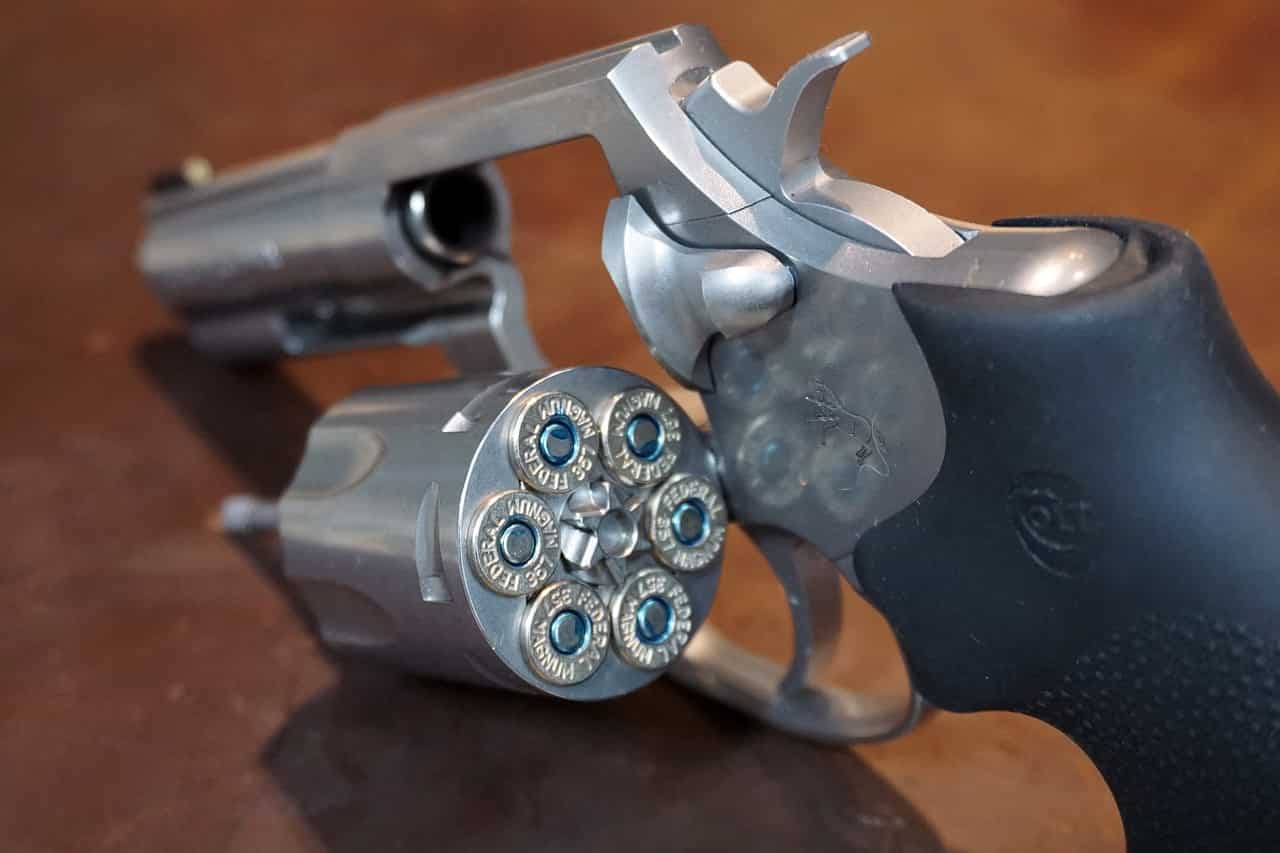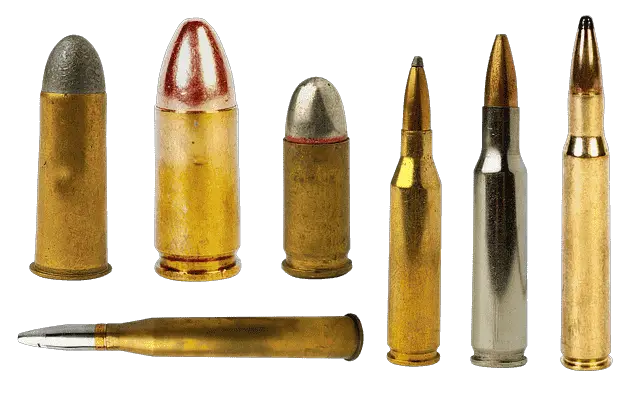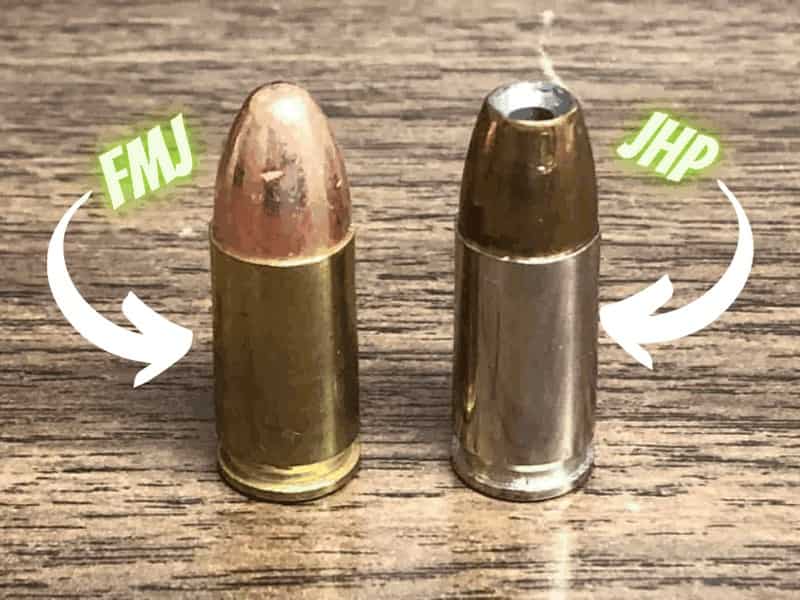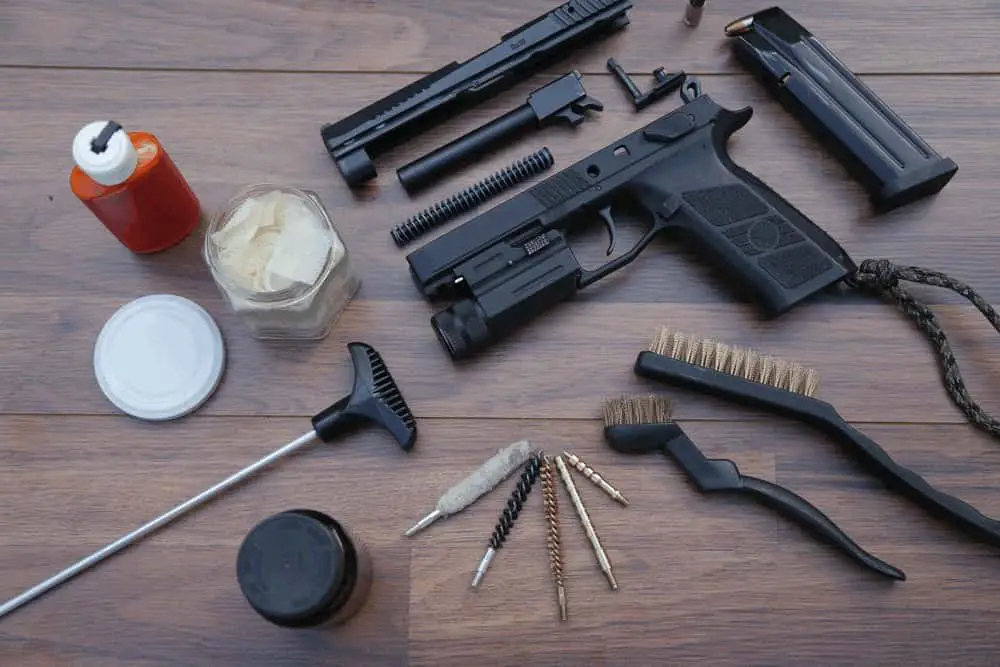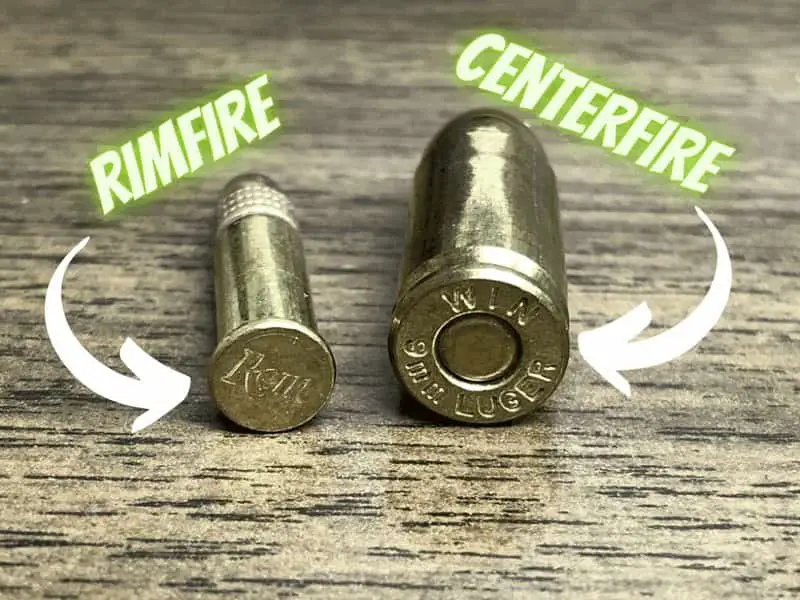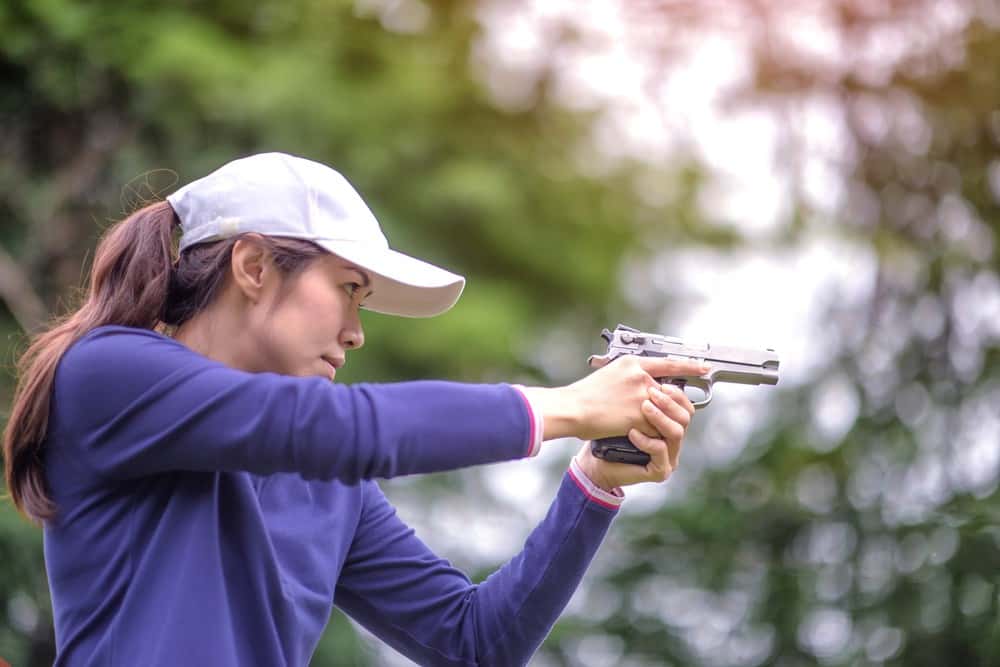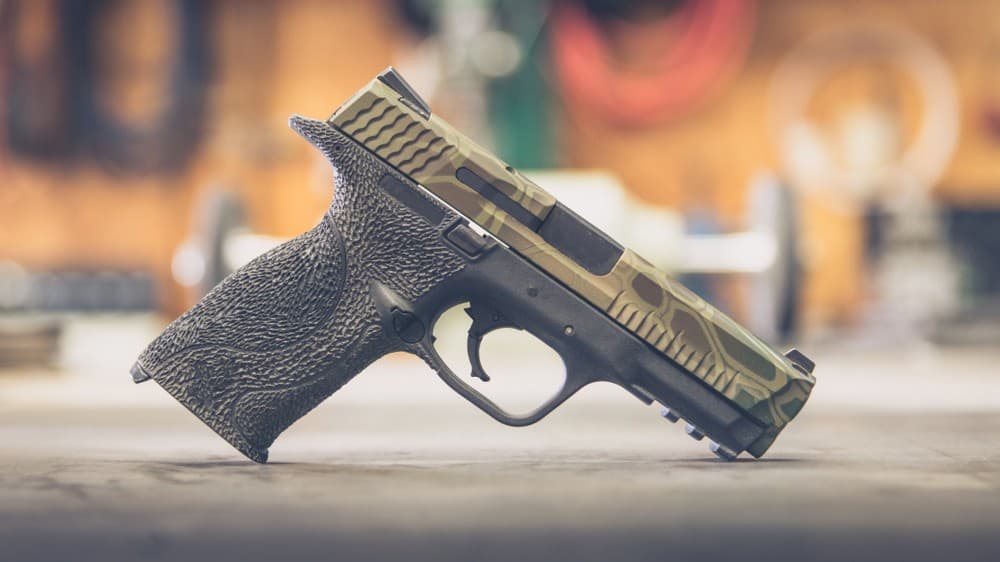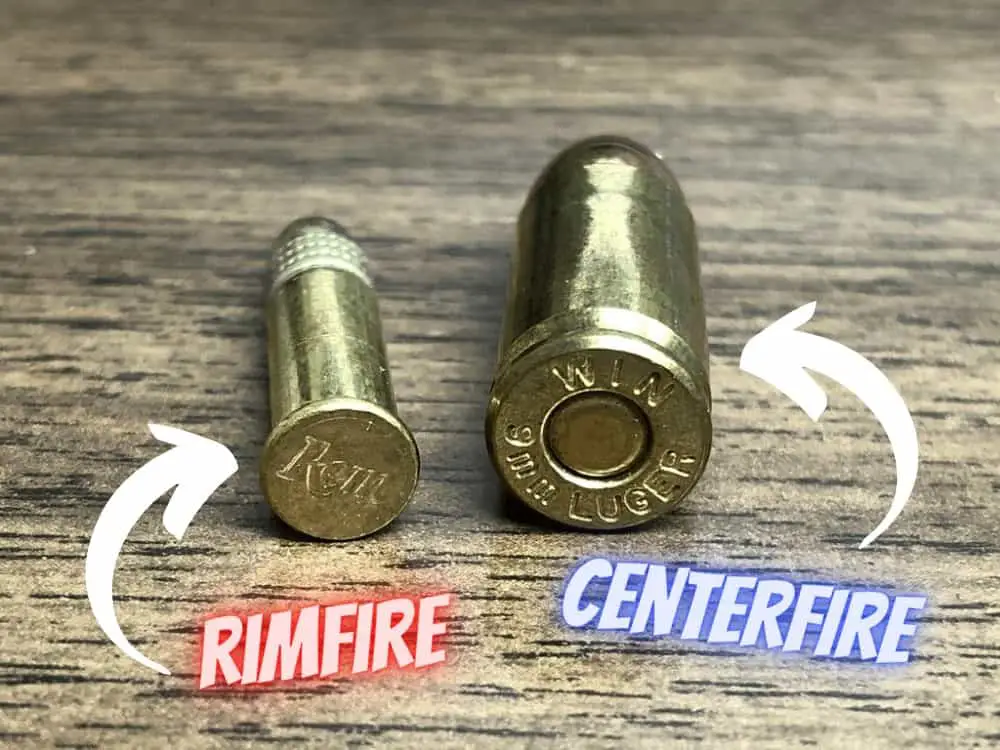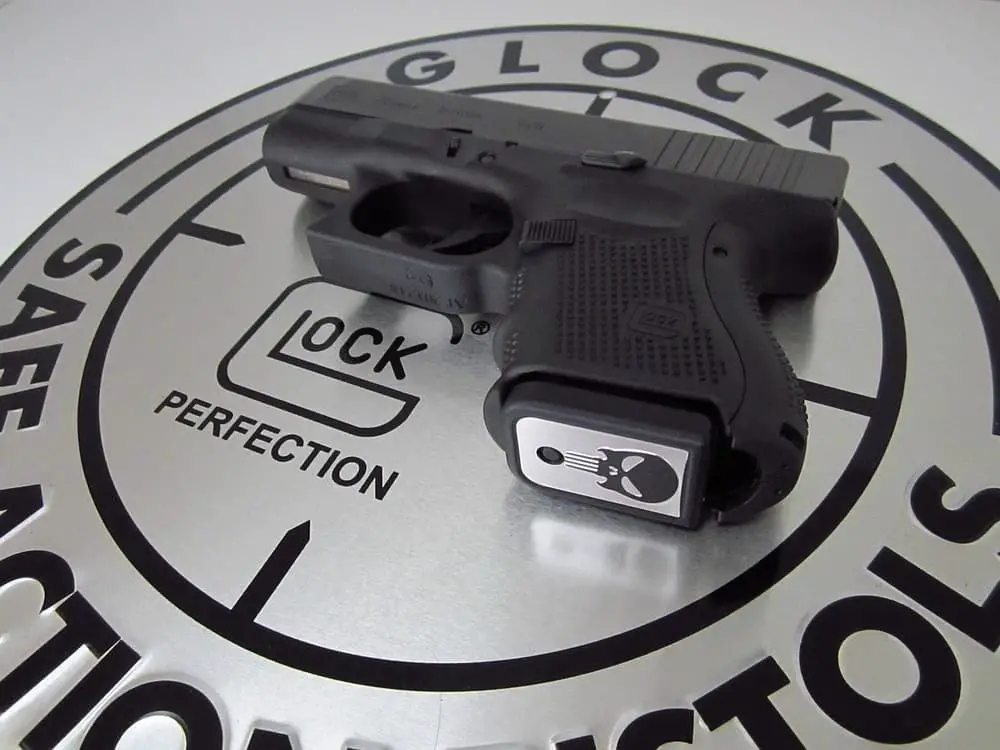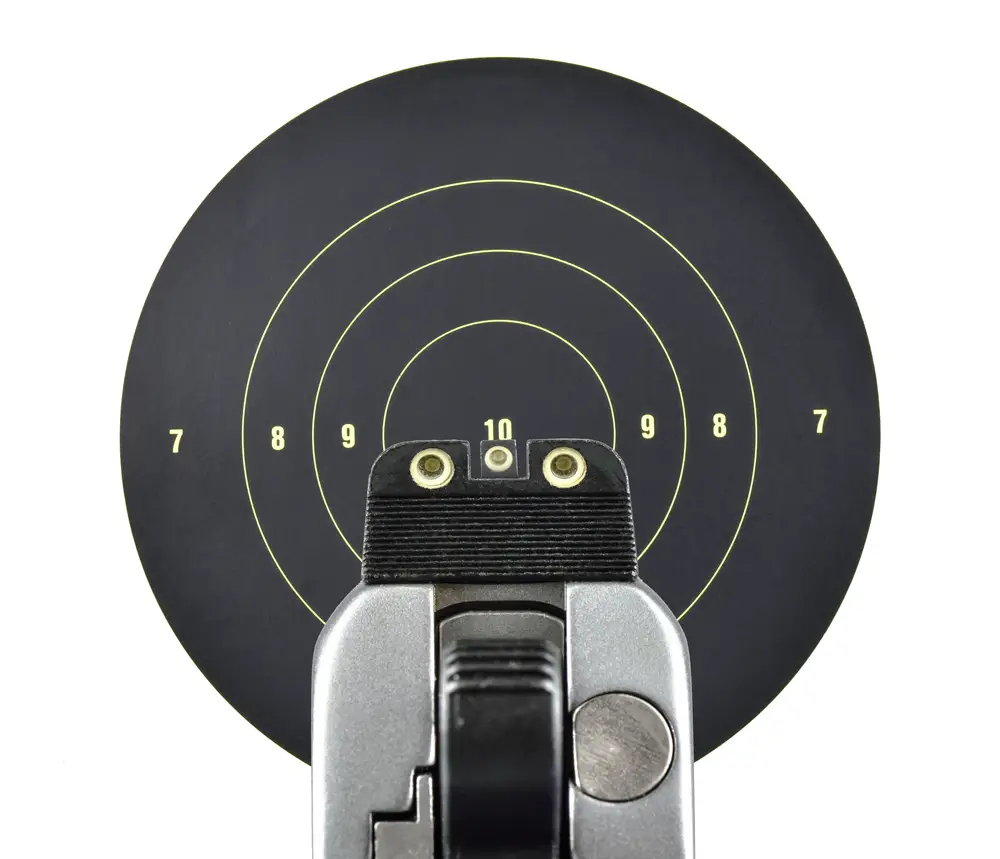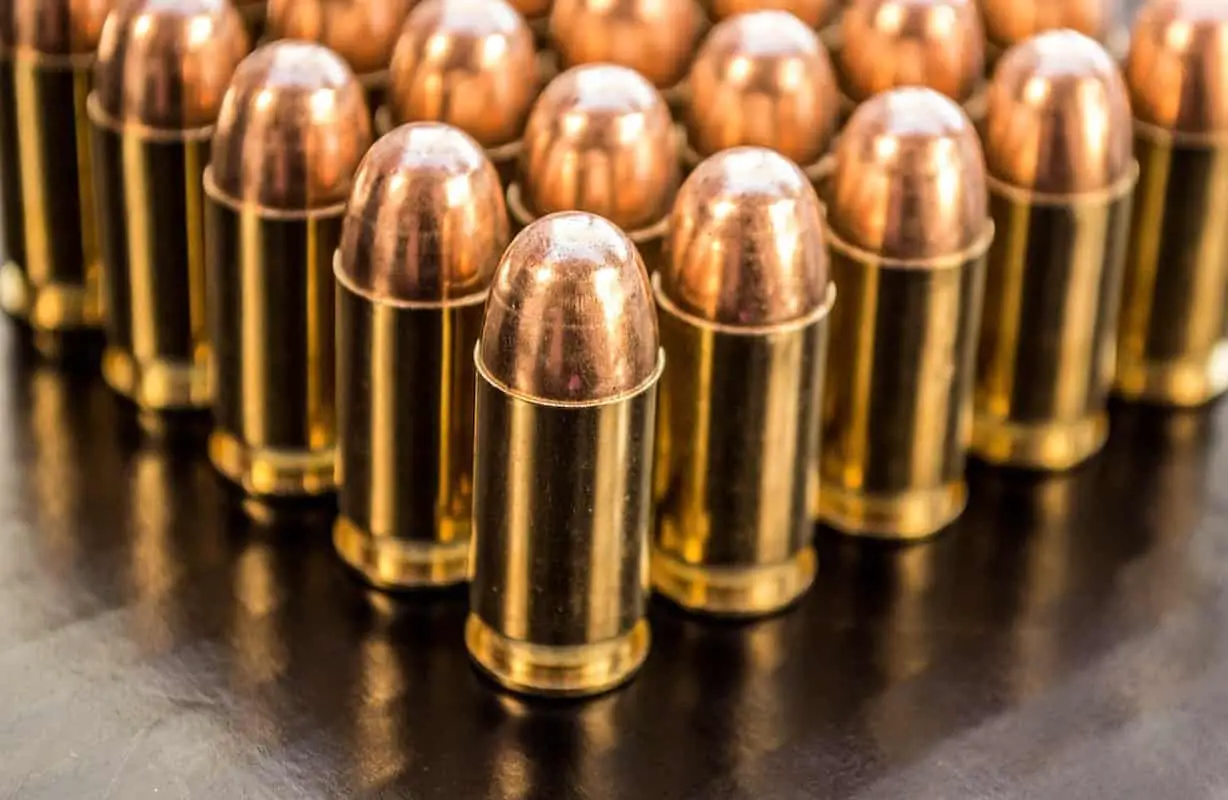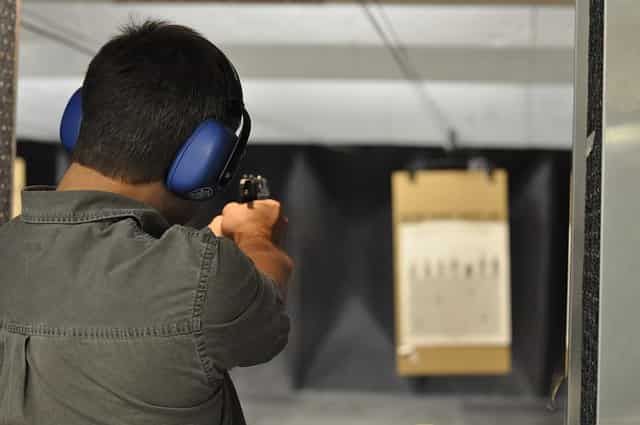
Shooting is a skill that requires a combination of focus, accuracy, and comfort. One of the most debated topics among shooters is whether to close one eye or keep both eyes open when aiming. Some believe that closing one eye helps to improve accuracy, while others argue that it limits the shooter’s field of vision and situational awareness.
The short answer is that eventually you need to learn to shoot with both eyes open. This technique may not be appropriate for all beginners, but keep reading for a more thorough explanation
What is Eye Dominance?
Eye dominance is the tendency for one eye to be more dominant than the other. This means that when both eyes are open, the brain will rely more on the visual information from the dominant eye. Eye dominance is determined by the brain, not the eyes themselves, and it is estimated that about two-thirds of the population have a dominant right eye, while the remaining third have a dominant left eye.
When it comes to shooting, eye dominance is particularly important. If a shooter is right-handed but has a dominant left eye, they may find it difficult to aim accurately with their right eye. This is because their brain is relying more on the visual information from their left eye, which is not aligned with the sights of the gun.
There are several ways to determine which eye is dominant, including the Miles test, the Porta test, and the hole-in-the-card test. These tests involve aligning an object or a hole with both eyes and seeing which eye the object or hole lines up with more accurately.
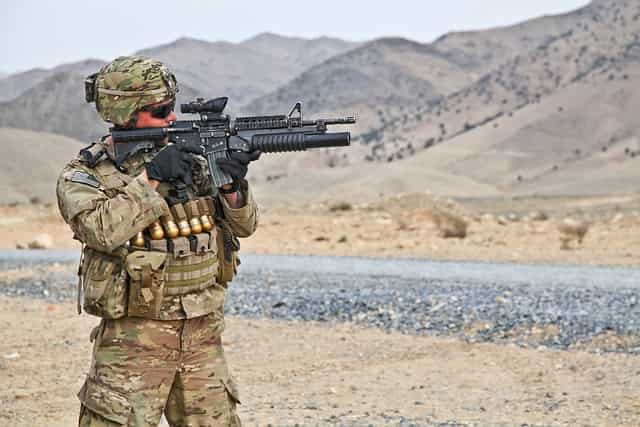
Should You Close One Eye When Shooting?
Advantages of Closing One Eye
Closing one eye while shooting has been a common technique for many years. Here are some advantages of closing one eye:
- Increased focus: Closing one eye can help you focus on your target more effectively. By eliminating visual distractions, you can concentrate on the task at hand and aim more accurately.
- Better sight alignment: Closing one eye can help you achieve better sight alignment. When you close one eye, you can align your dominant eye with the sights more easily, which can improve your accuracy.
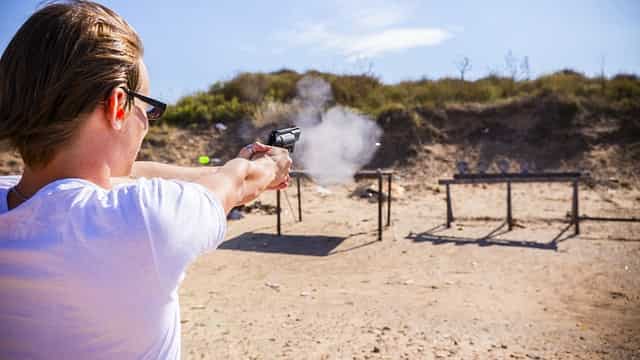
Disadvantages of Closing One Eye
While closing one eye has its advantages, it also has some disadvantages. Here are some of them:
- Reduced depth perception: Closing one eye can reduce your depth perception, making it harder to judge distances accurately. This can be a problem if you are shooting at moving targets or in situations where you need to quickly assess your surroundings.
- Limited field of view: Closing one eye can also limit your field of view. When you keep both eyes open, you have a wider field of view, which can help you spot potential threats or obstacles.
- Slower target acquisition: Closing one eye can slow down your target acquisition. By keeping both eyes open, you can quickly acquire your target and react more quickly to changing situations.
Keeping Both Eyes Open When Shooting
Advantages of Keeping Both Eyes Open
When it comes to shooting, many people believe that closing one eye is the only way to achieve accuracy. However, keeping both eyes open has several advantages.
First, keeping both eyes open allows for better depth perception. This is because the brain is able to process more information from both eyes, resulting in a more accurate perception of distance and spatial relationships.
Second, keeping both eyes open allows for better situational awareness. With both eyes open, the shooter is able to see their surroundings and potential threats, which is especially important in self-defense situations.
Third, keeping both eyes open reduces eye strain and fatigue. When one eye is closed, the other eye has to work harder to compensate for the loss of depth perception. This can lead to eye strain and fatigue, which can affect accuracy over time.
Disadvantages of Keeping Both Eyes Open
While there are several advantages to keeping both eyes open when shooting, there are also some disadvantages to consider.
One disadvantage is that keeping both eyes open can be distracting for some shooters. This is especially true for beginners who may find it difficult to focus on the target with both eyes open.
Another disadvantage is that keeping both eyes open can result in a wider field of view, which can be overwhelming for some shooters. This can make it more difficult to focus on the target and can lead to inaccurate shots.
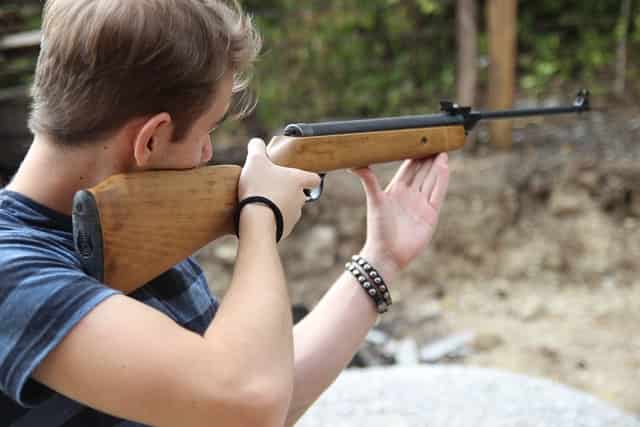
How to Shoot with Both Eyes Open
Shooting with both eyes open is a technique that can improve your accuracy and situational awareness. Here are some tips on how to shoot with both eyes open:
- Focus on the target: When shooting with both eyes open, it’s important to focus on the target and not on the sights. This can take some practice, but it will help you maintain your depth perception and peripheral vision.
- Use a dominant eye: If you have a dominant eye, use that eye to aim down the sights. This will help you maintain your accuracy while still keeping both eyes open.
- Practice: Shooting with both eyes open can take some getting used to, so it’s important to practice regularly. Start by shooting at close targets and gradually work your way up to longer distances.
- Use a red dot sight: Red dot sights can be particularly helpful when shooting with both eyes open. They allow you to keep both eyes open while still maintaining your accuracy.
- Keep both eyes open: It’s important to keep both eyes open when shooting with this technique. Closing one eye can reduce your depth perception and peripheral vision.
By following these tips, you can improve your accuracy and situational awareness when shooting with both eyes open.
How to Determine Your Dominant Eye
- Start by extending your arms and holding your hands together to form a small triangle between your thumbs and forefingers.
- With both eyes open, focus on a distant object through the triangle.
- Close one eye and then the other. The eye that keeps the object in view is your dominant eye.
Another way to determine your dominant eye is by using the Miles test. Here’s how to do it:
- Extend your arm and make a small circle with your thumb and forefinger.
- Keeping both eyes open, focus on an object in the distance and center it within the circle.
- Close one eye and then the other. The eye that keeps the object centered is your dominant eye.
It’s important to note that your dominant eye may not necessarily be the same as your dominant hand. It’s not uncommon for someone who is right-handed to have a dominant left eye.
Knowing your dominant eye is essential when it comes to shooting accurately. Once you’ve determined which eye is dominant, you can adjust your shooting stance and technique accordingly.
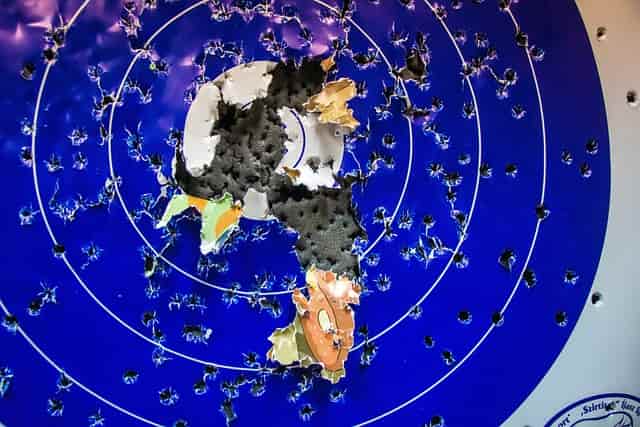
How to Aim with Both Eyes Open
When aiming with both eyes open, the shooter uses both eyes to focus on the target, allowing for greater depth perception and a wider field of view. Here are a few tips on how to aim with both eyes open:
- Focus on the target: The shooter should focus on the target with both eyes open, keeping the target in clear view. This helps the shooter to maintain situational awareness and be aware of any potential threats or obstacles in the surrounding environment.
- Sight picture: The shooter should align the sights with the target and focus on the front sight. The front sight should be in sharp focus, while the rear sight and the target are slightly out of focus. This helps the shooter to achieve a clear sight picture and accurately aim at the target.
- Front sight: The front sight is the most important part of the sight picture. The shooter should focus on the front sight and keep it aligned with the target. This helps the shooter to maintain accuracy and hit the target consistently.
- Practice: Aiming with both eyes open takes practice. The shooter should start by practicing on a stationary target and gradually move on to targets that move or require quick reaction times. Consistent practice will help the shooter to develop muscle memory and improve their accuracy.
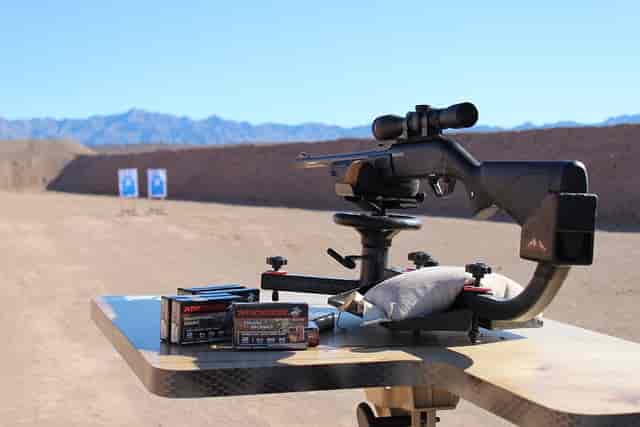
Situational Awareness and Peripheral Vision
When it comes to shooting, situational awareness and peripheral vision are critical factors that can affect the accuracy and safety of the shooter. Situational awareness refers to the ability to perceive and understand one’s surroundings and environment, while peripheral vision is the visual field outside the central vision.
Having good situational awareness and peripheral vision can help the shooter to identify potential threats, obstacles, and other hazards in their surroundings. This can be especially important in situations where the shooter needs to react quickly and make split-second decisions.
Peripheral vision can also help the shooter to maintain a wider field of view, which can be useful in tracking moving targets or monitoring multiple targets simultaneously. However, it is important to note that closing one eye when shooting can significantly reduce the shooter’s peripheral vision, which can make it more difficult to maintain situational awareness and track targets effectively.
In some situations, such as when shooting at long distances or in low-light conditions, closing one eye may be necessary to improve accuracy. However, it is important to weigh the benefits of improved accuracy against the potential risks of reduced situational awareness and peripheral vision.
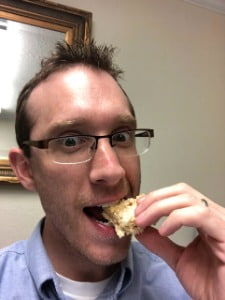
Jason Huskey
Owner of CCWClasses.net
Jason Huskey is a family man with three kids and a wonderful wife. He’s always starting new hobbies, but his true passion lies in shooting sports. Jason has been a CCW license holder for over 10 years and carries every day. In addition to firearms, he also enjoys playing guitar and writing songs. He tries to live by the Christian values he believes in.
More things you might enjoy…
Can a 38 Special Shoot 357 Rounds?
Image by MikeGunner from Pixabay I’ve long since discovered that very few activities give me the same thrill and sense of security as firing a gun. As a gun owner and enthusiast, I’ve always been curious about which guns can shoot which kinds of ammunition. I have a Derringer five-shot revolver that uses .22 rounds.…
Who Makes the Most Popular Brands of Ammo
If you are here to figure out who makes Herter’s ammo just look below the following table for a more thorough answer. If you are looking for a specific type of ammo, then you need to start by figuring out who makes it. There are lots of options for ammunition and each type of bullet…
What Does Full Metal Jacket Mean?
If you have heard the term full metal jacket, then you might be wondering what this means. I know that growing up, I heard this term a lot. I dismissed it as some sort of saying or cliche. Eventually, I decided that I needed to figure out what people meant when they use this term.…
How Often Should You Clean Your Gun?
After purchasing a firearm, you might wonder how often you should clean your gun. The truth is that it largely depends on how often you use it and where you live. Keep reading to learn more. How Often Should You Clean Your Gun? The short answer: do a light cleaning after every shooting session and…
What Is The Main Difference Between Centerfire And Rimfire Ammunition?
Rimfire vs Centerfire Everyone has to start somewhere. If you’re new to guns, learning the difference between rimfire and centerfire ammunition is important. Let me backtrack a moment. The first time I went out on the gun range, I had zero idea that there were different types of ammo for different types of weapons. All I knew…
Continue Reading What Is The Main Difference Between Centerfire And Rimfire Ammunition?
How Should You Hold a Handgun for Maximum Accuracy?
Whether it’s for sport or you find yourself in a defensive situation where you need to use a handgun, how you hold it will significantly affect your accuracy. Developing your handgun techniques will help you become a better shot and keep you safe. Read on to learn the answer to the question: How should you…
Continue Reading How Should You Hold a Handgun for Maximum Accuracy?
What Is Stippling On A Gun?
Hey, would you like a more firm grip on your gun? Would that help you shoot better? Well that is what stippling is for. Stippling is a modification to the grip that makes it, well, more grippy. It is done by sanding off the original finish and then using a hot soldering iron to make…
What Is A Centerfire Pistol?
To answer the question: “What Is A Centerfire Pistol?”, you must first understand that there are two main types of ammunition: Centerfire Rimfire These ammo categorizations are based on where the firing pin hits the back of the bullet to make it fire. A centerfire pistol is one where the firing pin strikes the center…
Is It Bad To Dry Fire A Glock?
There are loads of myths and assumptions surrounding handguns. If you grew up around guns, you probably heard some of these myths. Today, we will answer the question: Is it bad to dry fire a Glock. The Quick Answer Dry firing modern centerfire guns is completely fine (this includes most Glocks). The firing pin does…
What Is The Sight Picture?
When you first became interested in shooting you probably heard the terms sight picture and sight alignment being thrown around. Most people tend to use the two terms interchangeably; however, they do not mean the same thing. In this guide, I will make a clear distinction between sight picture and sight alignment. To master any new trade, you must…
What is Ball Ammo
When you hear the term “ball ammo” you may be picturing an actual ball. While the term did originate from ball shaped ammo, that’s not what it means today. Most ball ammo today is cylindrical in shape. It will have a lead core coated with copper. Keep reading to learn all about the history and…
